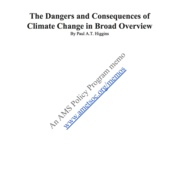By Paul A.T. Higgins ([email protected])
The views expressed in American Meteorological Society Policy Program memos are those of the author alone and do not necessarily reflect the views of the American Meteorological Society, its members, or sponsors.
After decades of intensive scientific research, a great deal is understood about the climate system and the impact people are having on it. Scientific evidence relating to climate change spans dozens of fields of study and includes work from tens of thousands of individual scientists. The evidence has been rigorously assessed and independently corroborated hundreds of times1.
Three broad conclusions result from comprehensive assessments of scientific evidence: 1) people are causing climate to change, particularly through greenhouse gas emissions; 2) human-caused climate change is dangerous and the consequences potentially dire; and 3) many response options can reduce the consequences2. These conclusions are based on multiple lines of evidence.
A great deal is understood about the potential consequences of climate change. Specific impacts of climate change are presented in comprehensive assessments3,4, and syntheses for broader audiences5. This memo offers an overarching perspective for understanding the danger of human-caused climate change.
As of the year 2020, scientists have determined with high confidence that:
-
Human activities have increased carbon dioxide concentrations in the atmosphere by 45% since the preindustrial period6,7
-
Human-caused increases in greenhouse gases are primarily responsible for global warming of 1.9°F since 18808,9
-
The consequences to people from climate change are large and increasing3-5
-
Warming changes the physical characteristics of the Earth (weather patterns; where land meets ocean; where ice and snow occur; the location, amount, and timing of water flows)10
-
Warming impacts biological systems: species locations; timing of key life events; and the provision of goods and services from natural and managed systems3
-
Warming impacts every aspect of social and economic life, including: public health; agricultural productivity; transportation; energy supply and demand; and national security3,4
-
Warming will continue from past human emissions10
-
Future human emissions will further increase our contribution to warming10
Future consequences will depend on: how much and how fast climate changes (i.e., how much people emit and whether nature also disturbs climate); how sensitive physical, biological, and social systems are to climate disturbance; and how unrelated events interact with climate change to reduce or amplify the consequences.
The consequences to people from climate change have four overarching characteristics:
First, consequences are already occurring3,4 and will almost certainly get worse. Warming from past emissions is ongoing and efforts to reduce consequences have been minimal to date. The physical characteristics of the Earth, biological resources on which people depend, and social institutions that we have created are all heavily tuned to climate and sensitive to change.
Second, larger and faster climate changes have greater consequences. Larger changes cause more disruption of physical, biological, and social systems and will be harder to manage. Faster changes give less time to plan and respond to impacts.
Third, very serious and catastrophic consequences are more likely than most realize. We often do not recognize, in our daily lives, the extent of goods and services that natural systems provide. Physical, biological, and human systems provide basic life support functions to people. These cannot be easily replaced. Humanity's success over the last 6,000 years has come with a largely unchanging climate. Even relatively small local and regional variation in climate has often had big impacts on the people affected. There is great potential for harm because virtually everything we have can be lost. The potential for gain is at the margin (i.e., minimal). Finally, sources of misinformation are widespread and effective at misleading the public.
There is no known safe level of climate change and we cannot know how much we can emit without triggering unacceptable consequences. The consequences of climate change will almost certainly exceed widely acceptable levels of impact.
Fourth, we could respond in ways that lessen the consequences and broadly benefit people by reducing the amount and speed of climate change, and/or by improving people's ability to deal with unavoidable impacts. Notably, our greenhouse gas emissions are primarily an unintended bi-product of meeting our current energy needs. Incentives can encourage alternatives for meeting those underlying needs without the harmful unintended consequences.
These four overarching characteristics of the consequences to people from climate change are well-established, unlikely to change with any additional information, and could inform decision-making on the issue.
References:
1. Higgins, P.A.T. 2019. How Trustworthy Are Scientific Assessments of Climate Change? https://bit.ly/31qgxRL.
2. Higgins, P.A.T. 2019. Options to Reduce the Consequences of Climate Change. https://bit.ly/38VCfBA.
3. IPCC WG2, AR5: https://www.ipcc.ch/report/ar5/wg2/
4. U.S. National Climate Assessment: https://nca2018.globalchange.gov/
5. World Economic Forum. 2020. The Global Risks Report 2020.
6. NOAA: https://www.esrl.noaa.gov/gmd/ccgg/trends/global.html
7. NASA: https://climate.nasa.gov/vital-signs/carbon-dioxide/
8. NASA: https://climate.nasa.gov/
9. National Academy of Sciences. 2020. Climate Change: Evidence and Causes: Update 2020. Washington, DC: The National Academies Press. https://doi.org/10.17226/25733.
10. IPCC WG1, AR5: https://www.ipcc.ch/report/ar5/wg1/
